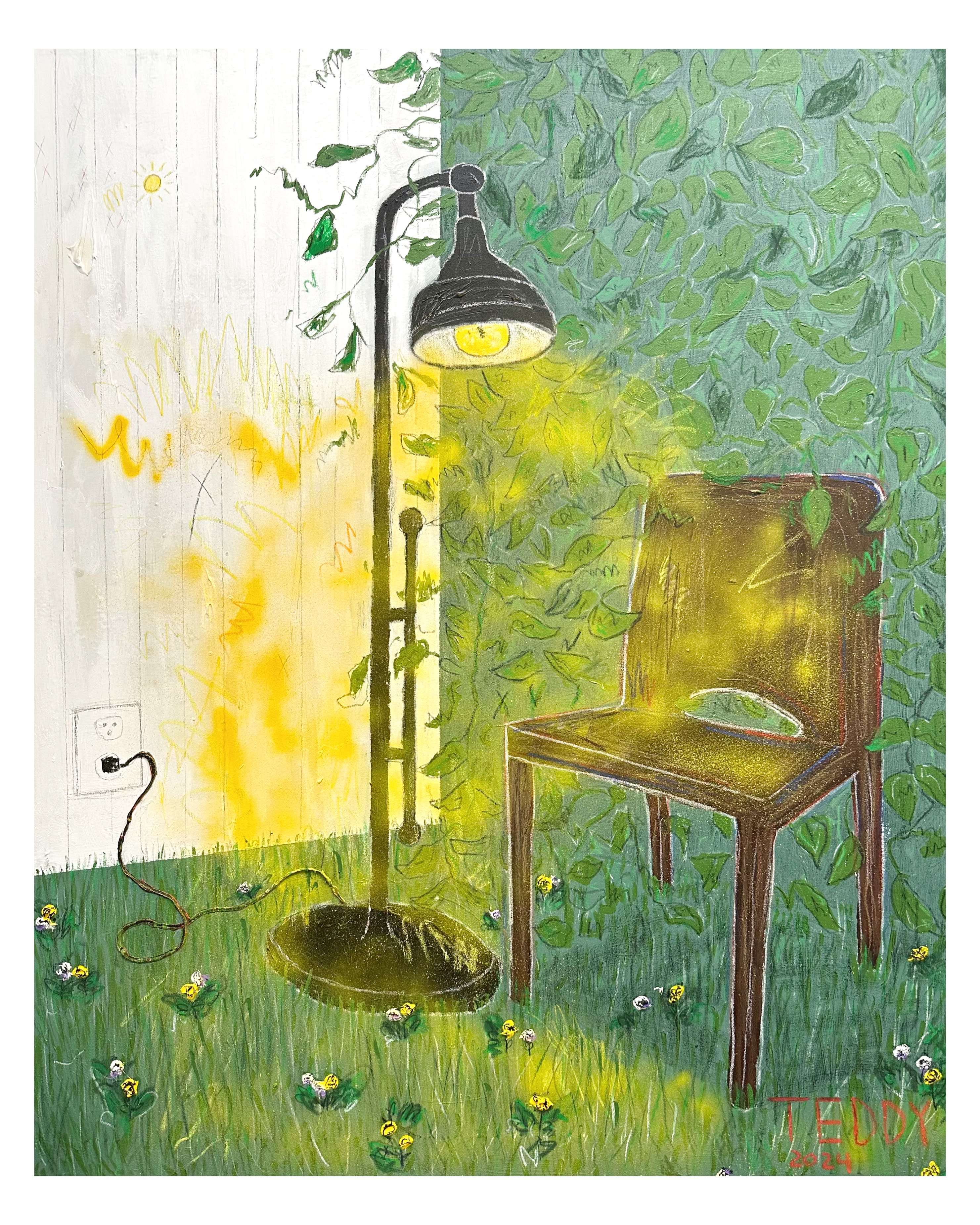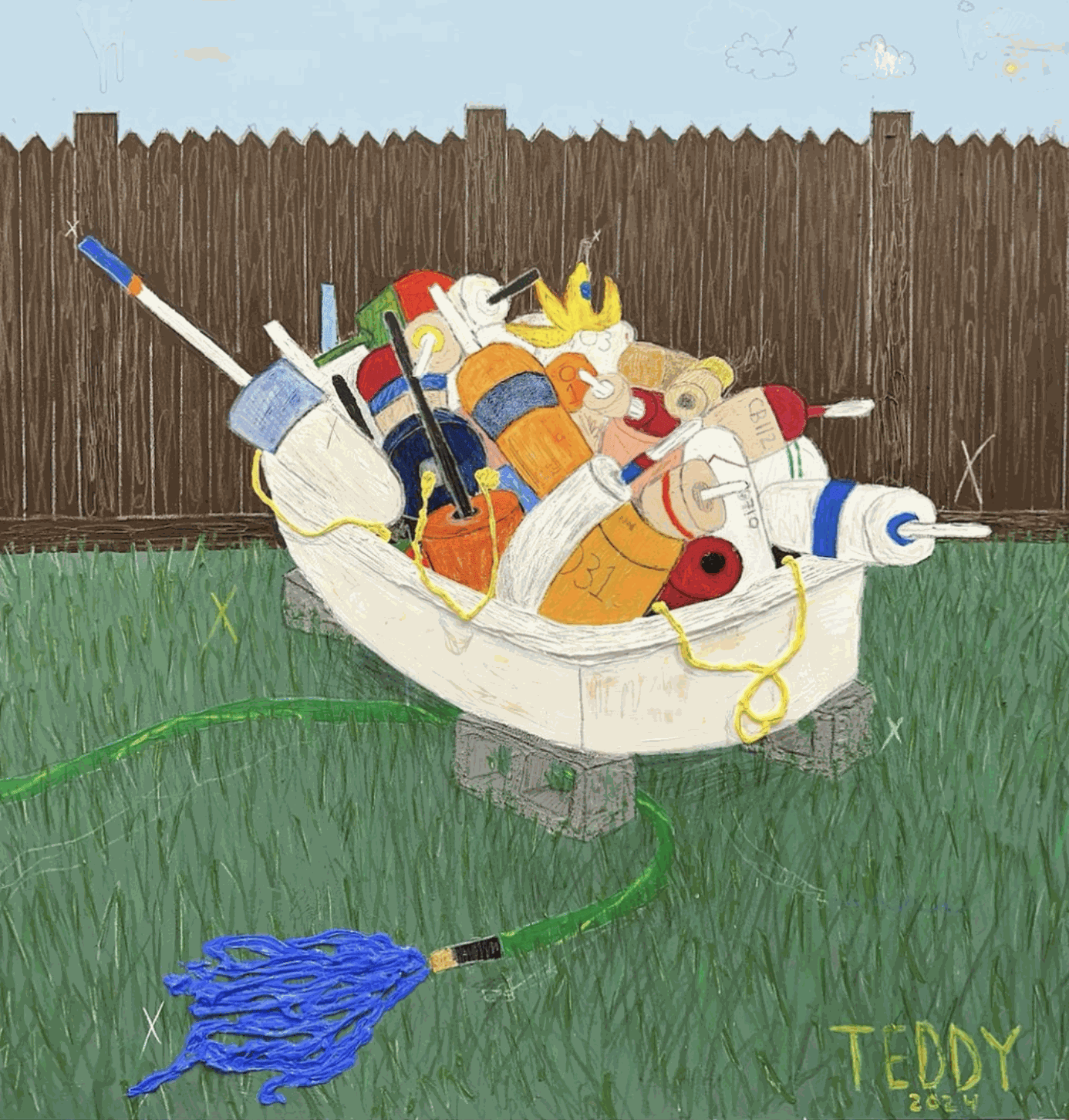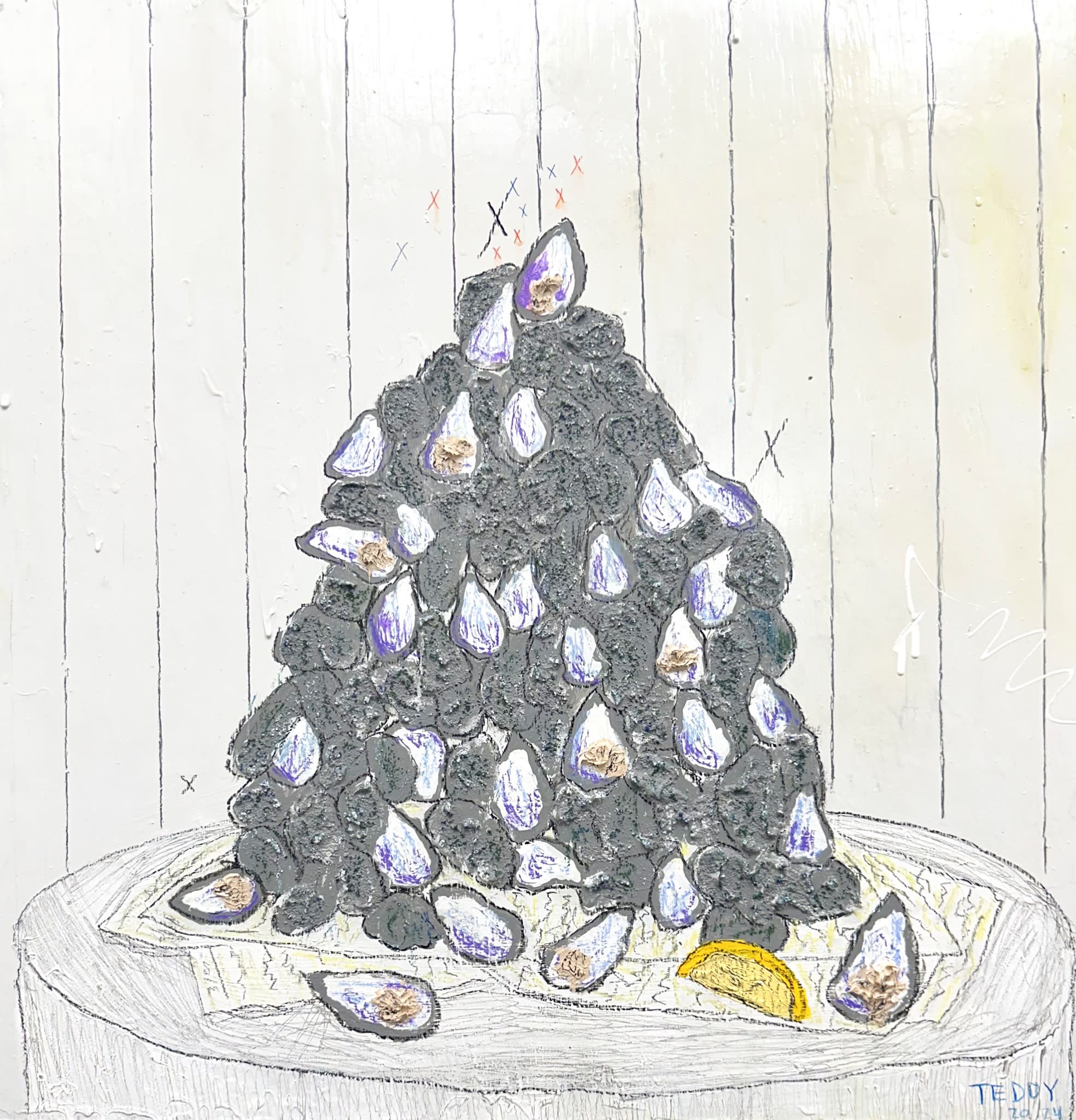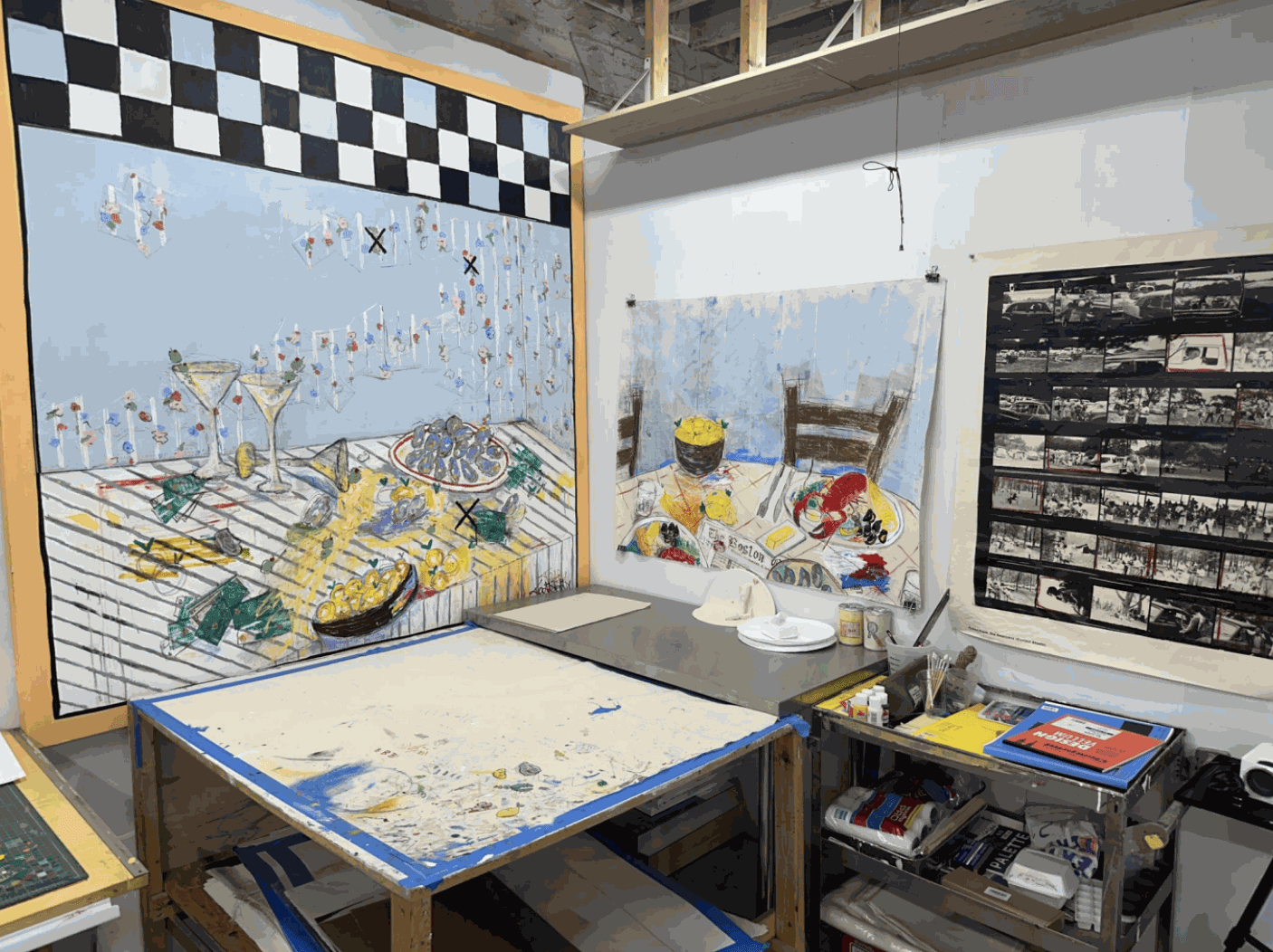Nalani Bouillon Interviews Teddy Benfield on His Artistic Inspirations and Techniques
Teddy Benfield is primarily a painter and photographer who focuses on still life. His work explores the intersection of traditional still life painting with contemporary consumerism and marketplace relationships, utilizing irony and internet culture.

By incorporating signage, branding, and shared imagery, Benfield blends modern products with interior spaces, transporting viewers through time and prompting them to question these environments.
His representational imagery bridges the past and present, paying homage to hand-painted signs and traditional still life, while also engaging with themes of class and value.
I reached out to Teddy to inquire about his artistic style and gain a deeper understanding of his creative practice.

Hey Teddy. I was trying to describe your work to someone by saying it’s sort of like painting meets ceramics meets photography, textiles, but it also has a collage element to it. How would you describe your work?
I tend to say my work is rooted in painting, specifically still life. I use a lot of house paint, acrylic paint, china markers and oil pastels. Heavy textures and mark makings create a push and pull to my work and I look to treat surfaces like walls or contact sheets in photography rather than the canvas or wood panels that they actually are.
Ceramics also lend themselves well to my work and has replaced the handmade paper element to my practice that I visited a few years ago. I enjoy using clay as a 3D element and hand painting it to reexamine the surface as a painting rather than a glazed ceramic work. Regardless of medium, I usually have a similar approach to my work and that is through painting and drawing.
 Teddy Benfield: Untitled,2021, house paint, acrylic paint, oil pastel, krink ink, ink, spray paint on canvas
Teddy Benfield: Untitled,2021, house paint, acrylic paint, oil pastel, krink ink, ink, spray paint on canvasWould you say your painting inspires your photography or vice versa?
Photography influences my work often as reference images these days. I take a lot of photographs and use bits and pieces of them to combine together to make a painting. Often photos I take of chairs, food and still life-adjacent things make their way into my paintings one way or another.
How would you describe your painting process? It looks like a lot of layers, like you paint over details?
My process does involve a lot of layers and edits. I begin with a quick sketch using pencil and crayon. From there I do a loose sketch on whatever surface I’m working on and prime the surface with house paint and acrylic paints.
 Teddy's Studio: image from artist
Teddy's Studio: image from artist
I build up textures with heavy body acrylic paints, spray paint, Roll-A-Tex (often used for house painting and creating wall/ ceiling texture) and oil pastels and china markers to finish.
I love to incorporate outlines and shadows and different forms of mark makings to replicate light source and different perspectives. Finally, I really enjoy working in a series so 99% of the time my imagery/ color palates end up in repetitions as my series develop.
What inspired you to mix mediums within your pieces?
Mixing mediums in my work comes from having a lot of different interests in different ways of mark making and finding specific uses for them. In art school I really enjoyed taking intro classes and learning the basics on new mediums and seeing how they apply directly to my painting practice.
 Teddy Benfield: Bananas On Board 2, 2024, house paint, acrylic paint, oil pastel, china marker, ink, spray paint, rollatex on canvas
Teddy Benfield: Bananas On Board 2, 2024, house paint, acrylic paint, oil pastel, china marker, ink, spray paint, rollatex on canvasCan you talk about the influence of the urban environment on your work?
I think the urban environment to my work introduces itself through my treatment of surfaces and materials. As I mentioned before, I like to treat surfaces like walls and constantly edit, cover up, cross out and replaces different elements to my work as I’m creating a painting. I use this as a way to blur the lines between interior and exterior spaces and the human relationship with each.
 Teddy Benfield:UNTITLED (PILE OF OYSTER SHELLS), 2024, House paint, acrylic paint, oil pastel, china marker, graphite, ink, spray paint on wood panel
Teddy Benfield:UNTITLED (PILE OF OYSTER SHELLS), 2024, House paint, acrylic paint, oil pastel, china marker, graphite, ink, spray paint on wood panelThe still lifes of seafood are incredibly done, is there a reason for creating specifically mollusks?
Thank you! Seafood and shell fish are a huge influence in my work because of where I grew up in Mystic, CT. It’s a small fishing town with a big tourism industry, specifically through seaports/ aquariums and the food and fishing industry.
Noticing the parallels between the subject matter in my work and traditional Dutch still life, I’ve been inspired to highlight the symbiotic relationship between the food and fishing industry, and the tourism industry to keep these small New England fishing towns thriving economically in months that traditionally are quiet.
 Teddy Benfield: Untitled (A Dozen LittleNecks),2023, house paint, acrylic paint, ink, oil pastel, china marker, on ceramic plate
Teddy Benfield: Untitled (A Dozen LittleNecks),2023, house paint, acrylic paint, ink, oil pastel, china marker, on ceramic plate
By both highlighting fine dining dishes and traditionally “lower class” cuisine, I look to create a relationship with still life in the same way the Dutch masters of the 17th century depicted goods imported from foreign countries. I use hyper regional seafood to create this sentiment of familiarity within the genre.
What do you do when you’re not creating? Do you have other interests or obsessions?
When I’m not creating in my studio I’m teaching 6th, 7th, and 8th grade studio art and ceramics at a small private school in Cambridge, MA. I also love spending time with my fiancée here in Boston. I like to go to Red Sox games, cook and see live music in the city. In the summer specifically we like to leave on weekends and head to the beach in Maine or Rhode Island where I surf as much as I can!
 Teddy's Studio: image from artist
Teddy's Studio: image from artistWhat’s the current Boston art scene like in terms of galleries and artists?
The art scene in Boston is small but tight knit. It’s rooted in academia as Boston has a zillion colleges within the city limits, but branches out into both a gallery and DIY scene. We have a section in the South End of the city called SoWa that’s home to a lot of galleries and small shops and hosts a “First Friday” gallery walk on the first Friday of every month.
I’m honored to have been a represented artist by Abigail Ogilvy Gallery since 2021 and it’s been so cool to be a part of the growth of the gallery, on both the east and west coasts. As for the DIY scene, music opportunities and other food related events have proven to be a unique way to bring creatives together and explore fine art through different events.
Nalani Bouillon is a dynamic writer, TikToker, and blogger specializing in contemporary arts. She runs The Artists Dispatch, a platform dedicated to showcasing the latest in the art world.

